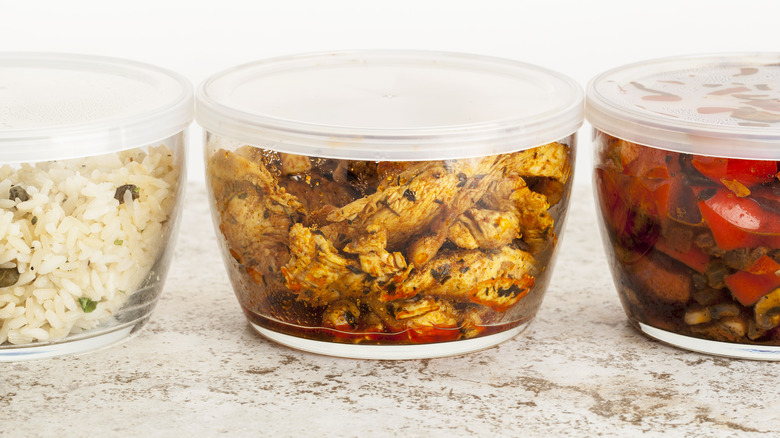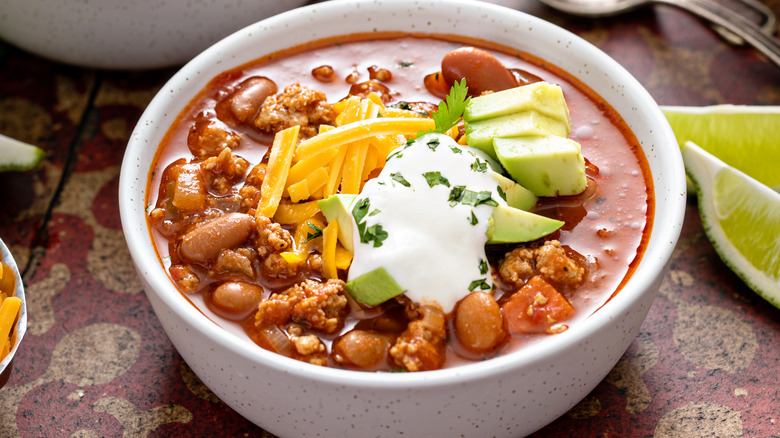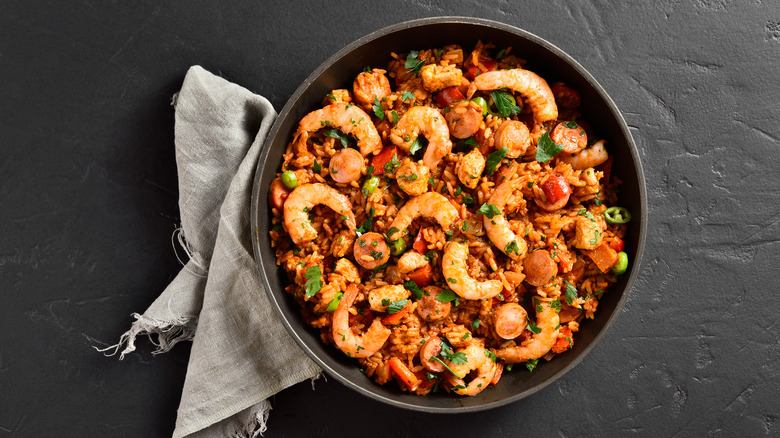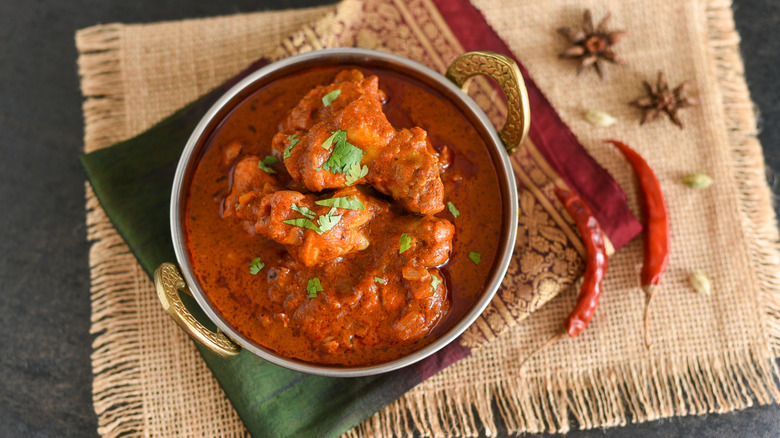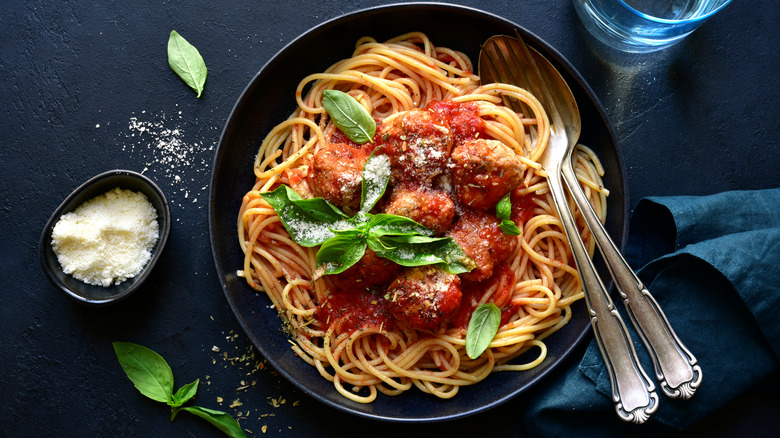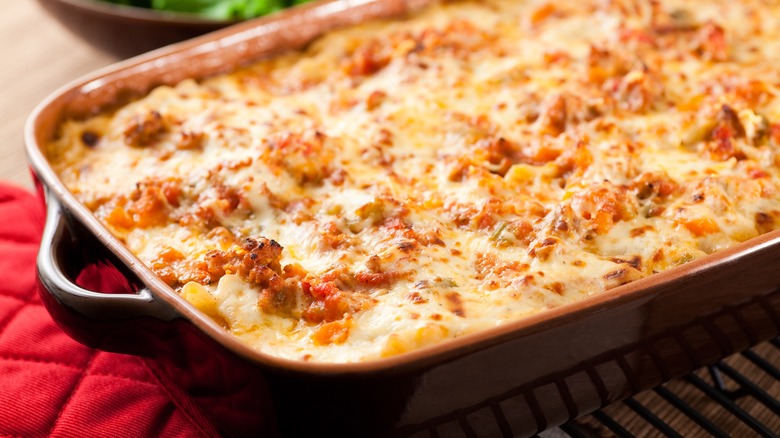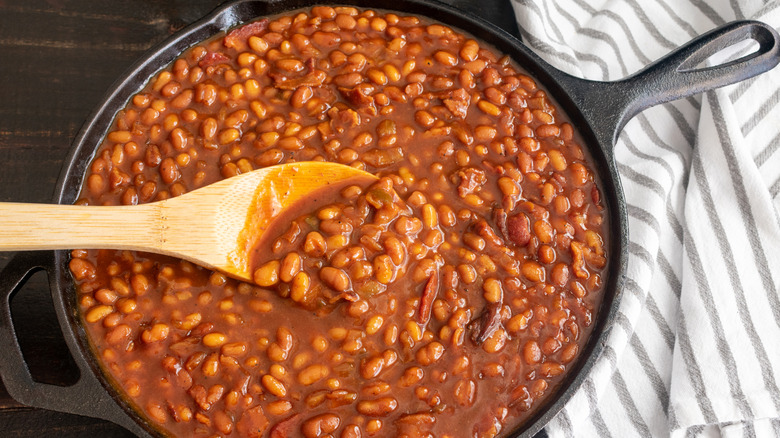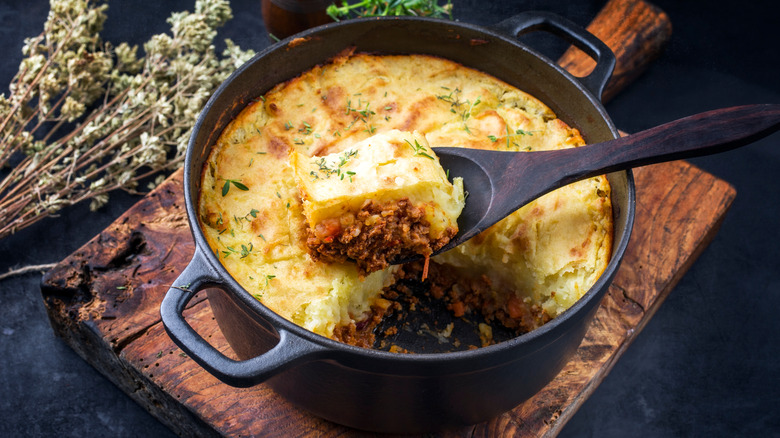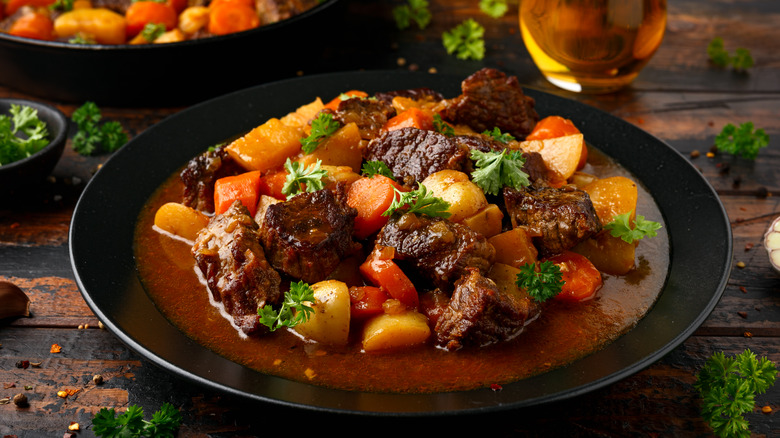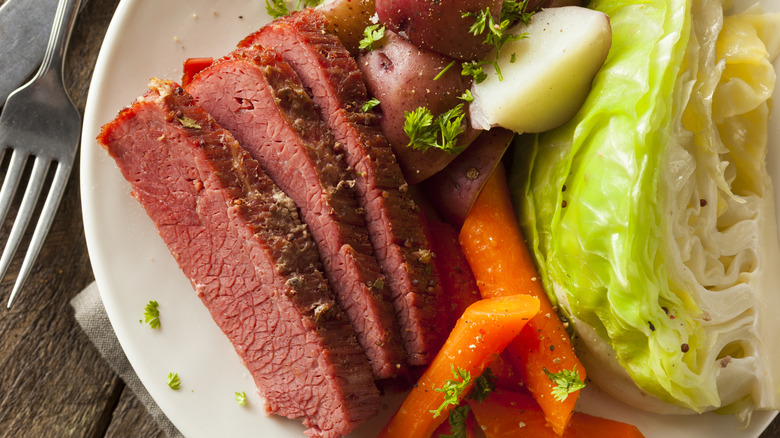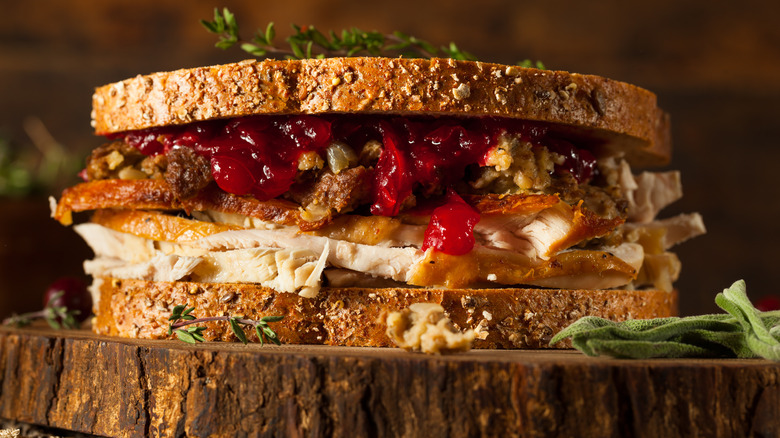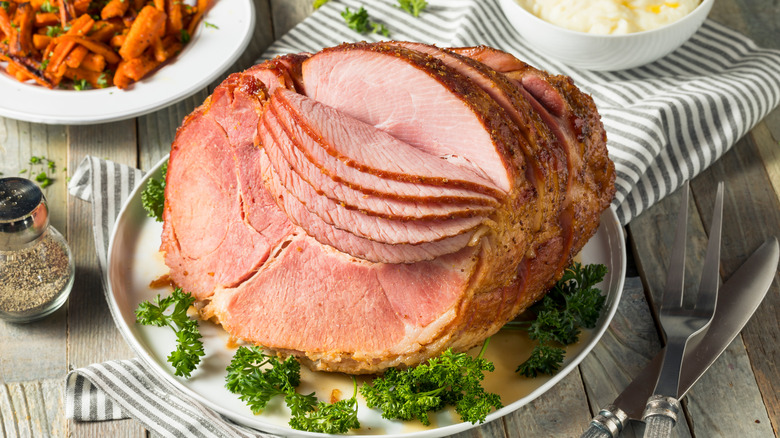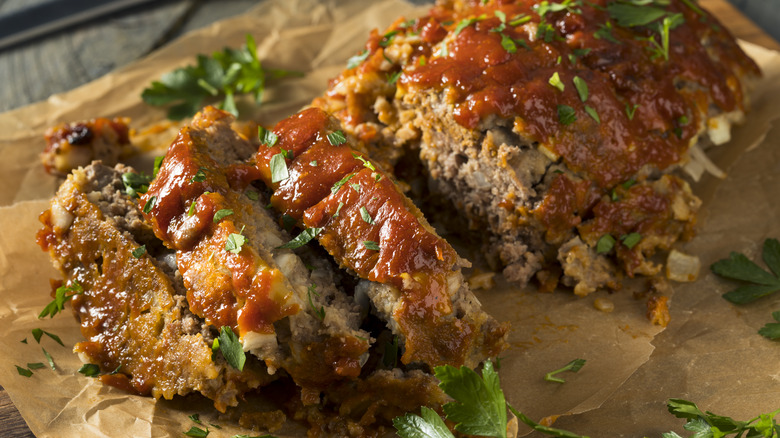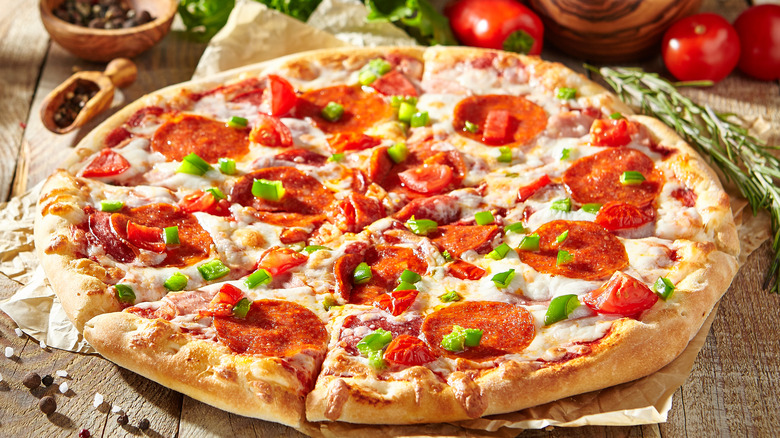13 Foods That Are Better When Reheated The Next Day
Happiness, to me, is a fridge full of leftovers. Past-Me was organized enough to not just make a great meal, but make enough of it that I don't have to think about lunch or dinner the following day. Not only do leftovers lessen the pain-point of meal planning, there are lots of foods that actually benefit from the extra resting time in the fridge.
Whether you're transforming your leftovers into a completely different meal, or just reheating it directly from the Tupperware, everyone has their favorite do-over dish. Not only do most dishes taste better the next day, it's also a great way of stretching your food budget by making one larger dish and enjoying it over the course of several meals. You might already have an idea of what meals improve with time, but we've complied a list of some of our favorites that are even better on the second day.
Chili
The GOAT of leftovers is indisputably chili. It's is such a hearty dish — loaded with beans, meat, and vegetables — that you can build the base of your chili to your own personal specifications. Whether you use kidney or pinto beans, ground beef, or chunks of chuck, when someone says they're making chili, no two recipes are ever identical.
There are lots of ways to elevate your chili, from melting in a square of dark chocolate to mixing in some cornmeal for additional thickness. When you add depth to your flavors, whether it's some cocoa or soy sauce for extra dimension, allowing the ingredients to bloom overnight means that when you reheat the chili the next day, you're going to have much richer flavors than you experienced when the dish was fresh.
Second-day chili is delicious in its natural state, directly from a bowl with a dollop of sour cream and shredded cheese. But it can also be transformed into different dishes as well. Adding reheated chili to hot dogs makes for a super easy, filling meal. You can also fold the chili into an omelet for brinner (the best of all meals). It can also serve as a topper for baked potatoes or nachos. Heck, make a love child of the two and scoop the chili onto tater tots, melt some cheese on there, and have tot-chos!
The spices, vegetables, and meat all cooperate to deepen and strengthen the flavor of chili which makes it even more delicious the following day.
Jambalaya
Spicy, smoky jambalaya, loaded with peppers, shellfish, and sausage, definitely benefits from a good night's rest in the fridge. Jambalaya is an easy one-pot style meal that is relatively simple to throw together, and basic enough to make a large initial batch that can be used for meals for the next several days.
Famous for being a staple dish from Louisiana, jambalaya comes in two varieties: Creole and Cajun. It's believed that jambalaya is an evolution of the Spanish dish, paella, loaded with rice and seafood. In metropolitan New Orleans, the saffron that gives paella its signature yellow hue was replaced with the more easily sourced tomatoes. Hence Creole jambalaya is often called "red" jambalaya. As the dish proliferated out away from the city and into the bayou, even tomatoes were hard to come by, meaning that the flavor of the dish relied more on the caramelization of the meat and rice, giving the Cajun version a toasted look and the moniker "brown" jambalaya.
Whether you prefer the red or brown version, both of them are steeped in spicy, smoky flavor from the herbs, spices, and andouille sausage that features prominently in the recipe. The bulk of jambalaya is rice, which acts like a sponge for all the delicious flavors that go into the dish. The longer the rice is allowed to steep in the flavors, the more delicious it becomes, making jambalaya even more enjoyable on the second day.
Curry
There's nothing more intoxicating than the complex, gorgeous scent of simmering curry. Be it vindaloo or tikka masala, the vibrant broth and chunky proteins are so delicious eaten over snowy jasmine rice or scooped up with fluffy naan bread.
Curry, itself, is not one singular thing. When you go to your local grocery store and see jars labeled "curry powder," it's actually a blend of spices, namely coriander, cumin, clove, cinnamon, mustard, ginger, and either red or black pepper for heat. Its distinctive yellow color comes from a healthy dose of turmeric. The ratio of all these different spices varies depending on region and even households in India. Your mother's curry blend might be completely different from her cousin's blend, just based on their locations and family traditions.
When you're working with that many strong spices, the flavor continues to develop even after the curry comes off the stove. Allowing your curry to sit overnight means that the dish will be even more flavorful the following day as those spices bloom and deepen as time goes on.
Spaghetti
Spaghetti (or really any pasta) and meat sauce is such an easy weekday dinner solution. It's so simple to boil water, add pasta, then dress up some jarred sauce. You can even make your own sauce from scratch if you're feeling fancy. No matter how you doll up your noodles, you typically end up with leftovers that are even more delicious the next day.
The best thing about pasta is that the noodles use their overnight foray in the fridge to absorb the herbaceous sauce, meaning each bite will be bursting with even more flavor. Of course, the quality of your leftovers is highly dependent on how you go about reheating the dish the next day. If you just throw the whole shebang into the microwave, you're going to end up with hot and cold spots and run the risk of drying out your noodles.
There are better ways of reheating your pasta which will make your second-day meal much more enjoyable. Taking the extra step to revitalize your sauce and noodles in a pan on the stove with a splash of broth or water to thin the sauce and rejuvenate the tomato juices will make a world of difference and ensure that your spaghetti is just as slurpable as when you first cooked it.
Lasagna
Lasagna is the ultimate traybake. Not only is it traditional and cozy, but it's also a great make-ahead meal to feed yourself and your family for days. Sky-high layers of noodles, sauce, cheese, vegetables, and meat converge in a dish, creating a symphony of gooey flavors.
There's a reason that lasagna is one of those meals that appears in people's kitchens when they've just had a baby, are grieving the death of a loved one, or otherwise need support from their communities. They're so filling and they can be eaten for several meals in a row. Most lasagnas live their entire lives, including the different ways they're reheated, in the same dish they were cooked in. How easy is that?
Much like spaghetti, the noodles of the lasagna absorb all the fantastic flavors of the sauce the longer it's allowed to sit, which means that they have a greater depth of flavor the next day.
Baked beans
Sweet and smoky with just a hint of tang, baked beans are a side dish that can be just as at home at breakfast or at a BBQ. Their saucy sweetness transcends mealtime labels, meaning that they can be eaten at almost any time of day. You can pile them onto toast or heap them next to your hamburgers and hot dogs. In New England diners, they're often found tucked into omelets.
While oftentimes, it's easiest to open a tin and heat them on the stove when you're craving beans, if you're truly invested in making a batch of beans that will last you for days, there are plenty of tips to make your beans even better. Doing something as simple as adding ham or bacon, which are smoked meats, will continue to impart flavor to the beans even after they're done cooking. Your choice of sweeteners also impacts the flavor of your beans. Molasses, honey, and maple syrup are all fantastic, multi-faceted sweeteners that add different tones to your baked beans.
The beans themselves suck up the saucy flavors, making sure that every bite is bursting with flavor. Don't be shy about adding next-day baked beans as a side to any dish.
Shepherd's pie
There are a lot of comfort foods that show up on this list. Maybe one of the traits of a true comfort food is the fact that they can be reheated and re-enjoyed on days when you are needing a culinary pick-me-up. Shepherd's pie is a comfort food's comfort food. Seasoned ground meat (traditionally lamb, though many recipes substitute ground beef), corn, carrots, and peas are snuggled under a pillowy top of fluffy mashed potatoes.
Like other larger scale tray-bakes, shepherd's pie typically yields plenty of leftovers. It's also a full meal in a bowl, meat, veggies, and starch all together in one dish. When you're looking for a quick lunch that checks all the boxes, or next day dinner that will hit the spot when you get home late, it's such a relief to know that you've got all the bases covered. Having a piping hot bowl of meat, vegetables, and potatoes that's had an extra day for the flavors to develop is the perfect way to close out a busy day when your brain is too fried to come up with a balanced meal.
Beef stew
One of the most popular slow cooker recipes out there is beef stew. It's a classic for a reason — you can take a not-so-great cut of meat, some hearty root vegetables, potatoes, and herbs and toss everything into the slow cooker, go about your day, then come home to your kitchen smelling like a dream. That tough, chewy piece of meat that you started cooking in the morning has been transformed into tender chunks, and the carrots and potatoes are spoon-soft, buttery delicious.
Reheated beef stew retains that same goodness. Whether you're using a spoon like a real adult, or just scooping it directly into your mouth with a slice of crusty bread like a giddy child, there's no wrong way to savor that stick-to-your-ribs favorite. This has a lot to do with what type of beef you use for the stew. Cuts like chuck or brisket are thick muscles, coming from areas of the cow that get the most use, meaning that the meat in its original state is very tough. However, the braising or stewing process of cooking the meat low and slow breaks down the collagen, making the meat more tender. This collagen is also a huge flavor boon, infusing the stewing liquid with a hearty, umami flavor that adds an additional dimension to the stew. So save yourself the money and buy a cheaper cut! You'll be enjoying the benefits for days after.
Corned beef
You might not know this, but the unofficial state dish of New Hampshire is something called "Boiled Dinner." This almost sounds like a parody, as New Hampshire isn't known for its culinary creativity. If you're not from the Granite State, you might know it by a less Dickensian moniker of corned beef and cabbage. For most people, this dish only shows up once a year as a novelty on St. Patrick's Day. But if you spend time in New England, you'll find it as a staple on many diner, tavern, and bed and breakfast menus.
While the easiest use for leftover corned beef is a towering Dagwood of a sandwich, you can also use it to elevate your brunch game by making corned beef hash from scratch. Forget the sad, tiny cubes of potatoes, and mushy meat that you find in the canned hash you might be familiar with. When you have thick slices of corned beef, some leftover potatoes, and even boiled cabbage, these elements can all be tossed into a hot skillet and caramelized until they have a delightful crunch. They make the perfect bed for a couple of fried or poached eggs, and the best remedy for that post-St. Paddy's Day hangover.
Thanksgiving leftovers
Speaking of holiday leftovers, Thanksgiving is probably the supreme champion of next-day eats. Sure, stuffing yourself on the actual holiday is great, but there's something special about the meals that you can concoct in the days that follow from the buffet of Tupperware that fill your fridge. Thanksgiving leftover recipes are practically a culinary category in and of themselves.
You can make huge sandwiches with slabs of turkey, gobs of stuffing, and a slather of cranberry sauce. But sandwiches are merely the beginning. Why settle for a cold sandwich when you can break out your waffle iron and make yourself some hot, crispy savory waffles? Just shred the turkey, mix it with the stuffing and mashed potatoes, moisten by folding in an egg, and scoop it onto the waffle iron. You'll end up with a waffle that can either be topped with leftover gravy, maple syrup for sweetness, or a dollop of cranberry sauce.
Turkey soup, sweet potato fritters, or even a Thanksgiving shepherd's pie can all be put together from all the elements that are left in the wake of Thanksgiving. You might find yourself looking forward to the leftovers more than the original holiday meal.
Spiral ham
Massive spiral-cut hams are another holiday centerpiece that inspire days of leftover meals. Much like turkey and corned beef, there are always sandwiches in a honey-baked ham's future. Or you can reheat slices of ham either in a skillet or in the oven.
Ham can also be an excellent bacon substitute in the breakfasts that follow Easter dinner. Quiches are a light, springtime solution to revitalizing your ham into an easy meal. You can use ham instead of bacon in the traditional quiche Lorraine, giving yourself a great secondary dish that can be easily packed up for light lunches.
You can also cube ham up to make ham and bean soup to chase away wintery chills. Ham soups are an especially great use for the bone that you'll find in the center of most ham roasts. Don't even think about just tossing that bone! It's loaded with fantastic flavors and marrow, which, when cooked in a soup stock, will give you a fantastic bone broth, replete with uses in your cooking for days to come.
Meatloaf
The humble meatloaf has found itself as the butt of jokes for unappetizing homecooked meals. It certainly doesn't deserve this reputation. If your meatloaf is dry and flavorless, you might be committing some culinary sins in your meatloaf preparation. You'll want to make sure that you're seasoning your meat, using the proper starches to bulk up the loaf, and adding plenty of vegetables to the mix. This will ensure that you end up with a moist, flavorful meal.
When you have leftover meatloaf, break out the panini press! Meatloaf makes killer sandwiches, and to elevate your experience, get it nice and toasty in the hot panini press. You can layer cheese, caramelized onion, bacon, and pretty much whatever you can imagine between the slices of bread before pressing it into a melty, gooey sandwich that will be even better than the original meal. The herby, hearty slices of meatloaf will fill you up and tickle that familiar nostalgia.
If you want to just enjoy the meatloaf in its natural state without the hassle of sandwich preparation, be sure that you're grilling or sauteing the meatloaf slices. This method creates a delightful caramelized crust on the meat which makes it even more delicious.
Pizza
What? You thought we were going to make this list without including pizza? We all might be guilty of leaving a box of pizza on the counter and just dipping into it well into the next day. The post-party counter-pizza is probably the only next-morning guest you want to see after a late-night bash. Leftover pizza is practically its own entry in the food pyramid during the college (and post-college) years.
Of course, you don't have to suffer through room-temperature, almost-stale pizza slices. If you want to really revitalize the pizza to its former glory, there are several simple solutions to reheating pizza. The toaster oven is a quick way to ensure the crust doesn't become a soggy mess on you. But simply putting your pizza into a skillet on the stovetop will bring your slices back to life in a way that will have you questioning why you ever microwaved pizza in the past.
